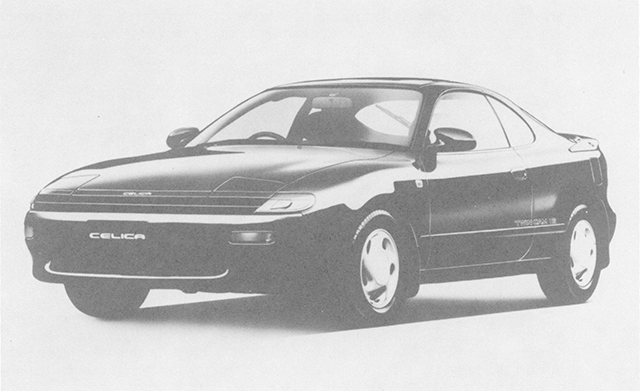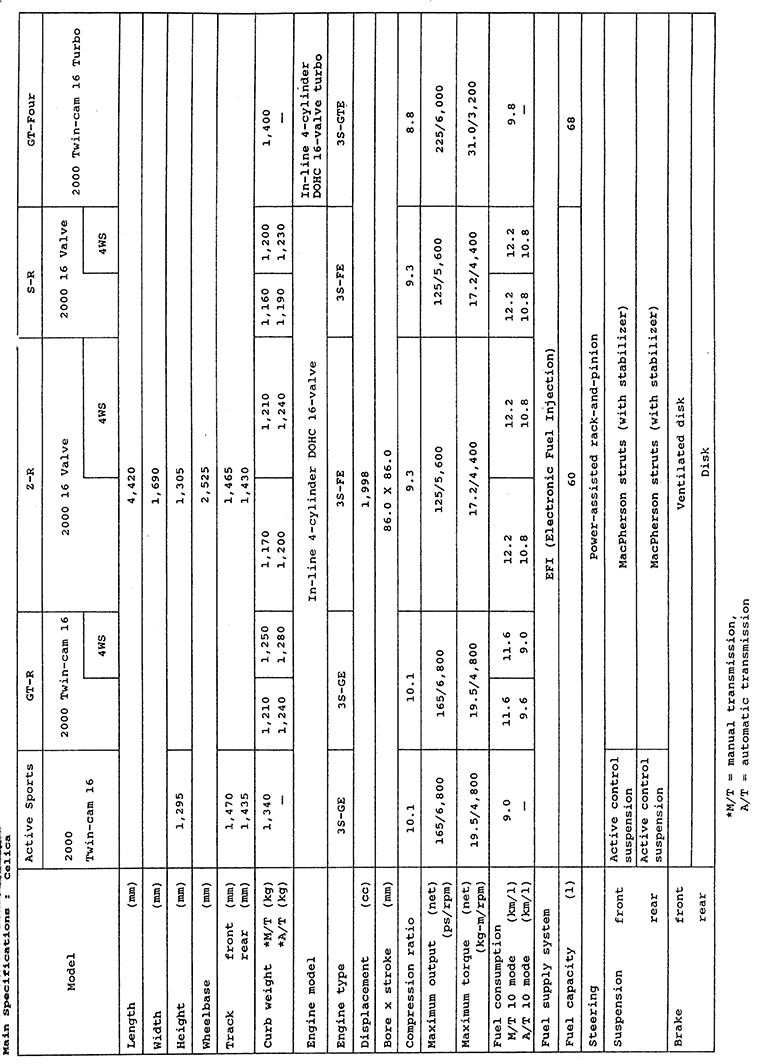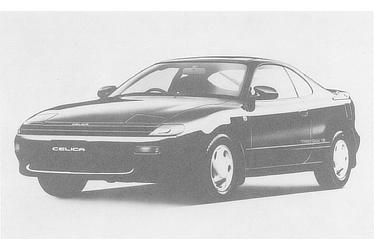Sep. 06, 1989
FULL MODEL CHANGES FOR CELICA
New Celica Debuts with Technological Edges
Toyota City―TOYOTA MOTOR CORPORATION announced today full model changes for its Celica high-performance specialty car, which will go on sale immediately nationwide.

Celica GT-R
The new Celica was developed on the basic concept of creating a car to satisfy the desires of fashion-conscious individuals, providing futuristic features in style and ride.
- A special style based on a theme of "futuristic features";
- High performance that gives the driver a sporty feeling, especially through emphasis on the hard-driving GT-Four; and
- Pursuit of a special taste that ensures a feeling of fun.
To accomplish these objectives, Toyota combined its advanced technologies in developing the new Celica and lavishly incorporated its challenging new technologies, which will contribute to further progress in automobiles.
-
Futuristic aerodynamic form
The new Celica creates a new trend in specialty style through an all-new aerodynamic form that positively conveys an image of a futuristic concept car, and which, at a glance, indicates it has been built for sporty driving pleasure.
The car also creates a forceful as well as artistic impression by blending a "super round" greenhouse with the lower body formed by new dynamically curved lines. -
Dual-mode 4WS
The speed-responsive electronically controlled four-wheel steering (4WS) features a dual mode that lets the driver choose between "sports" and "normal" steering characteristics to suit his or her personal taste.
The 4WS system allows the driver to control the steering angle of the rear wheels according to the steering angle of the front wheels, taking the vehicle speed into consideration―the rear wheels are counter-steered at low speed and synchro-steered at high speed. It thus achieves easier maneuvering in tight cornering, very sharp handling, and outstanding driving stability at high speed. -
Toyota Actively Controlled Suspension system (World's First)
The newly developed Toyota Actively Controlled Suspension system is a super-advanced mechanism that confers active electronic control over the four hydropneumatic suspensions independently.
The system eliminates almost all rolling, pitching, and other types of uncomfortable riding features during starting, acceleration, braking, and cornering. It also minimizes shaking or shock to the car due to road irregularities.
Thus, its excellent riding comfort is achieved at no cost to driveability or riding stability. -
Mechanical-sensor SRS airbag
The New Celica features include, among others, a compact airbag system with all components neatly packed inside the steering wheel pad. It includes a mechanical-sensor mechanism as a Supplemental Restraint System (SRS) in addition to the seat belt, especially for protecting the face in the event of a frontal collision.
-
Toyota Super Live Sound System
A special effort was made to emphasize the audio system indispensable to driving enjoyment. For initial introduction of the Toyota Super Live Sound System, a 10-speaker, six-amplifier system was installed in the new Celica in order to accommodate compact discs and other sophisticated sources of commercially available music entertainment on the road.
In developing the new audio system, acoustic characteristics inside the car's cabin were thoroughly scrutinized to determine optimal matching of the speakers in terms of their materials, shape, and size, as well as total coordination with the car body. The total 220W maximum output from the powerful six-amplifier system provides a heavy low-pitched sound that covers the entire dynamic range of music sources, and very clear and pleasant mid-to-high sound.
-
Twin-entry ceramic turbocharger
The 3S-GTE engine carried on the Celica GT-Four has a "twin entry" type of exhaust manifold and turbine housing passage that are designed to eliminate exhaust gas interference from the cylinders. The ceramic turbine wheel, which was designed, developed, and manufactured independently by Toyota, is used to reduce the weight of the turbine wheel itself. Coupled with the use of a special coating on the compressor housing, the new design ensures a dramatic increase in turbocharger response and efficiency.
-
Torque-sensing LSD
A newly adopted torque-sensing limited-slip differential (LSD) is used in the rear differential of the Celica GT-Four.
It is a new type of LSD using worm gears and is designed to distribute torque automatically and optimally to each wheel according to road conditions.
The purchase reservation for the Celica GT-Four will begin on September 7, and delivery will begin from the end of October.
Toyota will produce, in small quantities, the Celica Active Sports model equipped with Toyota's Actively Controlled Suspension system. Taking delivery into consideration, the company will receive orders for this model up to a limited quantity.
The company will accept an initial 300 purchase reservations from September 7 to the end of October, and the car will be delivered in the spring of next year. Under the company's current plan, reservations for the second limited sale will be taken in the fall of 1990.
- Engine
- 1-1
- All of the new Celica models are powered by 2-liter, twin-cam 16-valve engines to implement a dynamic performance that promises sporty driving pleasure.
- 1-2
-
The 3S-GTE engine for the Celica GT-Four model, running on unleaded gasoline fuel, has such new features as the twin-entry ceramic turbocharger and air-cooled intercooler. The result is a high-performance engine, the most powerful of all 2,000cc-class engines, boasting maximum output of 225ps at 6,000rpm, up 40ps from the previous type, and maximum torque of 31.0kg-m at 3,200rpm, up 6.5kg-m.
The twin-entry ceramic turbocharger has a dual-entry system for the exhaust manifold and for the turbine housing passage―with the first and fourth cylinders separated from the second and third cylinders in a two-group design. This ensures that no two exhaust valves are open simultaneously within a group at any time, eliminating interference by exhaust gases going to the turbocharger. This design suppresses energy loss and increases the response of the turbine wheel, which, in turn, enhances the engine's turbocharging efficiency.
In addition, the turbine wheel itself is made of ceramics to reduce substantially its moment of inertia.
- 1-3
-
The 3S-GE engine, running on unleaded gasoline fuel, has such new features as a new type of variable induction system and exhaust manifolds that are made of stainless steel pipe. The result is a remarkable gain in performance with the maximum output of 165ps at 6,800rpm (up 25ps from the previous type) and maximum torque of 19.5kg-m at 4,800rpm (up 2.0kg-m from the previous type).
In addition to the conventional surge tank, the newly adopted variable induction system has a second surge tank (located on the downstream side) that opens on the way to the intake manifold. Intake control valves, which are positioned in cylinder passages leading to the second surge tank, are opened in the high-speed range, virtually shortening the intake pipe length, and closed in the low-speed range, increasing it, so that intake air inertia is used more advantageously to deliver high output and torque in all low- to high-speed ranges.
- 1-4
- The shape of the combustion chamber and the valve timing of the 3S-FE engine were modified to increase the engine's maximum output to 125ps at 5,600rpm (up 5ps from the previous engine).
- Chassis and Drivetrain
- 2-1
The new Celica has a strut-type four-wheel independent suspension system, in which the steering geometry and all component parts were newly designed, based on the design architecture for the highly reputable FF chassis.
The new front suspension system was developed with special consideration given to improving the feeling of steering, primarily through reduced fluctuation of the steering torque during starting and acceleration. This was realized, among other factors, by means of a Vorlauf geometry (the king pi being offset to the rear of the vehicle) and a substantial reduction in the kingpin offset. Ball bushings are used in the two suspension arms in the rear suspension, and the front-to-rear span of the lower arms was extended to increase suspension rigidity. The result is markedly improved straight-ahead stability, turning performance, and riding comfort.
- 2-2
-
The newly developed dual-mode 4WS is based on speed-responsive electronically controlled 4WS designed to follow driver handling accurately. The new system has two handling modes, normal and sports, so the driver can choose between them.
Basically, the rear wheels are turned according to vehicle speed and the steering angle of the front wheels. When the car is running at low speed, the rear wheels are counter-steered to the front wheels, while at high speed they are synchro-steered. The maximum turning angle of the rear wheels is 5.0°.
The four-wheel steering drive significantly reduces the smallest turning radius at low speed to 4.7m, or 0.5m less than in the conventional two-wheel steering, so the car can be handled more easily. When the car is driven at high speed, the new system makes lane change and cornering easier, noticeably giving the driver the feel of total control.
Of the two steering modes, the sports mode is designed in such a way that rear wheel steering changes from counter-steer to synchro-steer at a higher vehicle speed than in the normal mode.
The four-wheel steering can be canceled by drivers who prefer standard two-wheel steering, especially for backing.
- 2-3
The newly developed Toyota Actively Controlled Suspension is a full-scale hydropneumatic active suspension system, in which oil pressure and the amount of oil in the shock absorber have independent electronic control for each of the four wheels from the oil supply pump and accumulator via pressure control valves.
The running condition of the car is sensed or forecast based on information supplied by a variety of sensors that monitor vehicle speed, steering angle, vehicle height, and acceleration. Oil pressure and the amount of oil in the shock absorber are externally regulated by supplying more oil to the absorber and discharging oil from it accordingly. The pneumatic pressure in the air spring, built inside the absorber, is also controlled secondarily. In other words, the vehicle position (rolling, pitching, diving, height) and riding comfort (damping of vibration due to road irregularities) are wholly controlled according to the car's running conditions and road conditions to radically improve driveability and driving stability without affecting basic riding comfort.
- 2-4
- The anti-lock brake system (ABS) is standard equipment on some models, and optionally available on all others, to maintain vehicle stability and driveability on slippery roads.
- 2-5
A "super flow" torque convertor is newly installed on all automatic transmission models. The oil flow is digitally analyzed most strictly to achieve a higher torque conversion ratio and to implement one of the highest transmission efficiencies.
Automatic transmission models equipped with the 3S-GE engine have a newly developed ECT-S designed to control totally the engine and transmission. The complete control over the engine output provides smoother gear-shift feeling and gives greater driving pleasure.
- 2-6
The rear differential of the Celica GT-Four has the torque sensing LSD, which distributes the drive torque optimally to the right and left wheels according to the input torque.
The torque-sensing LSD primarily consists of two side gears (worm gears) and six element gears (spur gears and worm wheels). Torque is distributed in an optimal fashion, mainly by utilizing the tooth surface friction of the worm gears.
- Body
- 3-1
- Structural joints are more generously reinforced and high-tension steel sheets are used more effectively than ever before in the body shell to construct a more rigid and yet more lightweight body.
- 3-2
- Sandwich damper panels with asphalt sheet in between two steel panels are used generously in the dash panels, front floor tunnel, and inner wheel housing to minimize vibration and noise transmission from the engine and the drive line. yAn asphalt sheet with resin-made restraint layer, consisting of a viscous and elastic layer with a resin sheet covering, is used on the floor to reduce substantially the vibration and noise.
- 3-3
- The body is made with the least possible steps on the body surface and gaps between body panels. The flush-surface design gives a more refined and attractive appearance to the car while dramatically reducing wind noise.
-
New Mechanisms and Equipment
The new Celica features an airbag system, incorporating the mechanical-sensor mechanism as an SRS to the seat belt, especially for protecting the face in the event of a frontal collision.
All related parts, such as sensors, inflator (gas generator), and the bag, are neatly contained in the steering wheel pad, and when the stroke of the shockdetecting ball exceeds a predetermined value owing to a collision, it triggers an ignition pin. The pin hits the igniting chemicals in the inflator, which are fired by the energy of the pin, and gas is generated quickly as a result. The bag is inflated in front of the driver as soon as a collision shock is detected, reducing the physical shock to the face.






